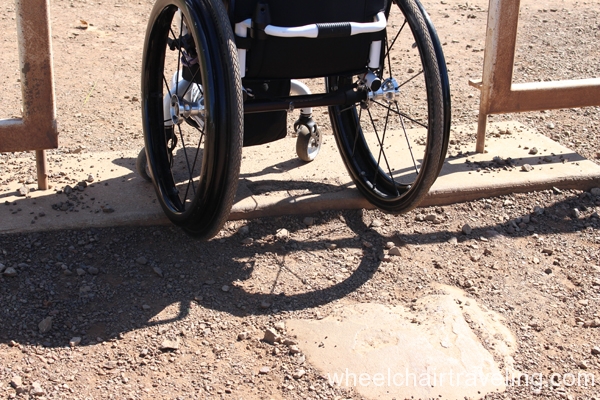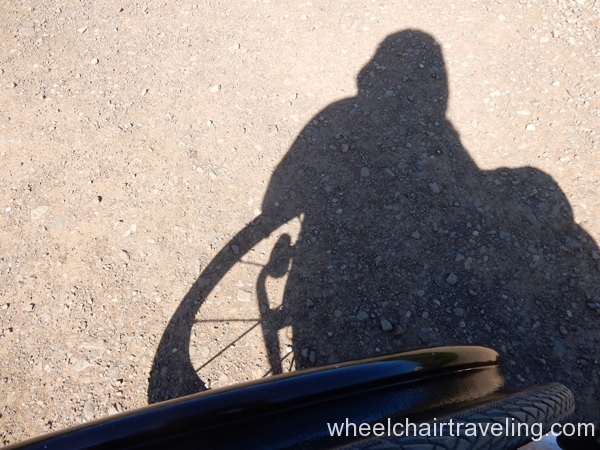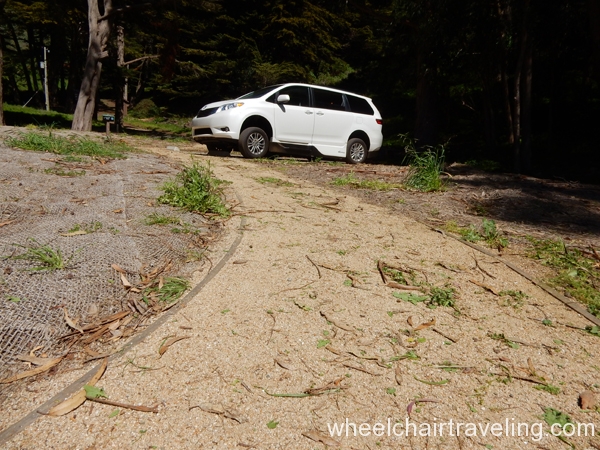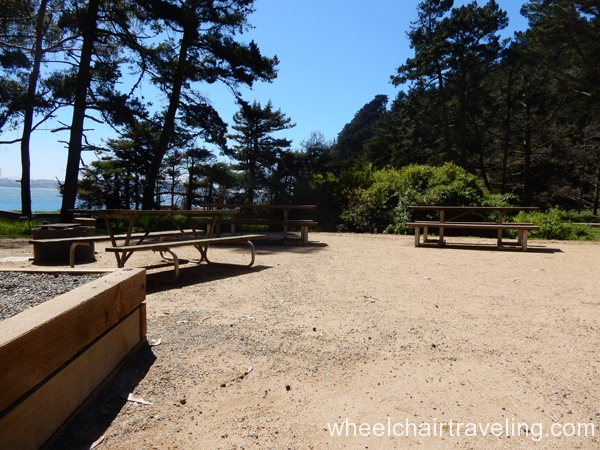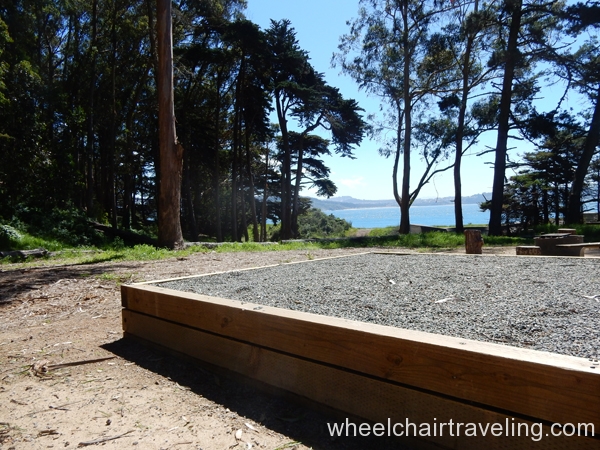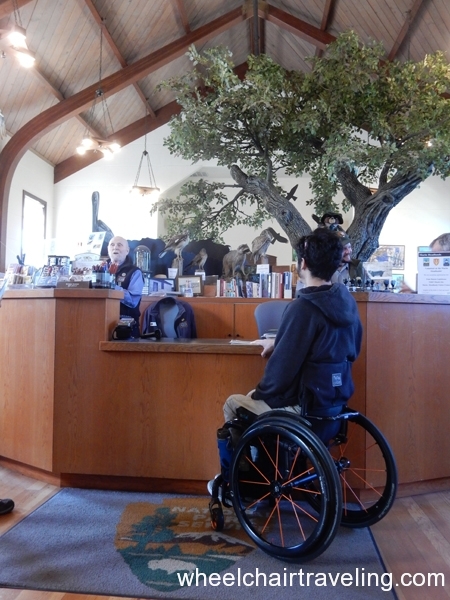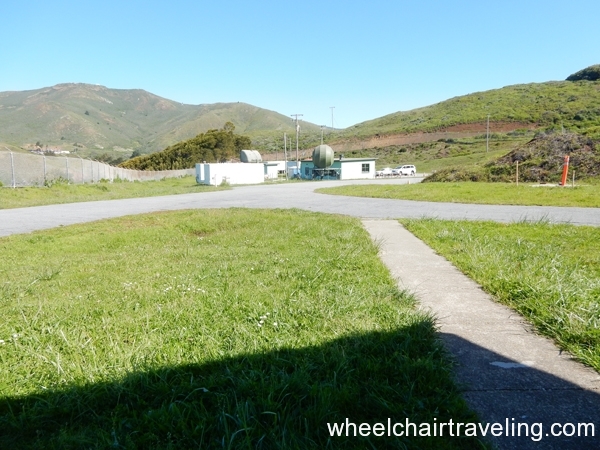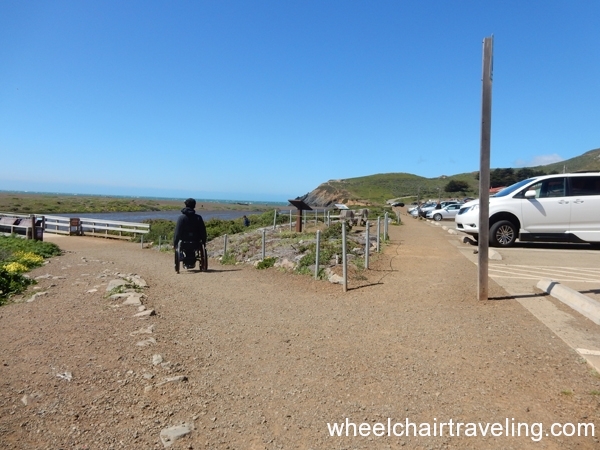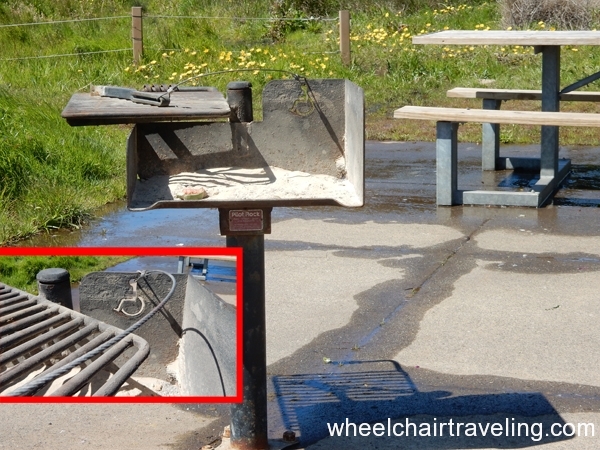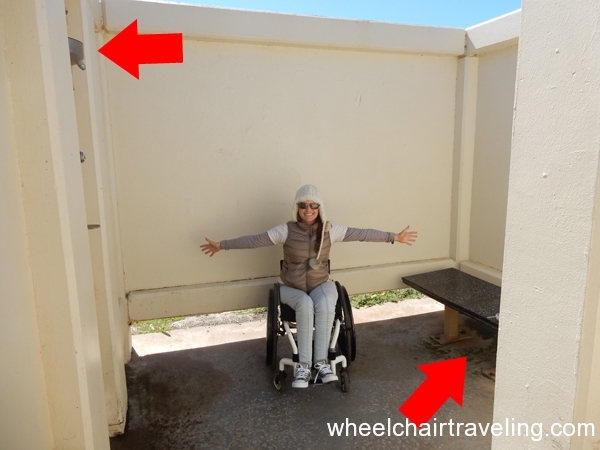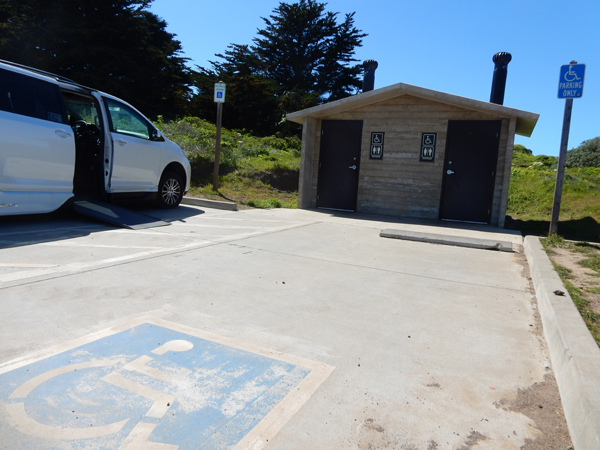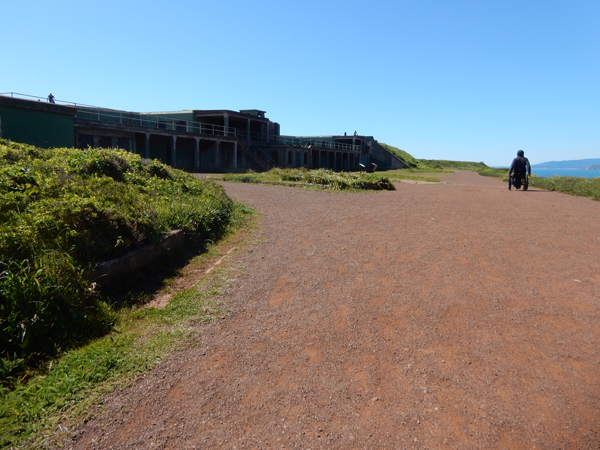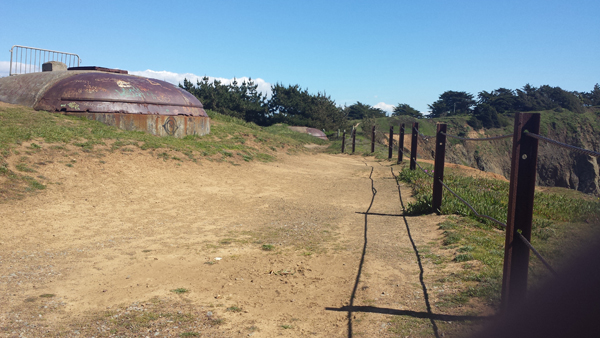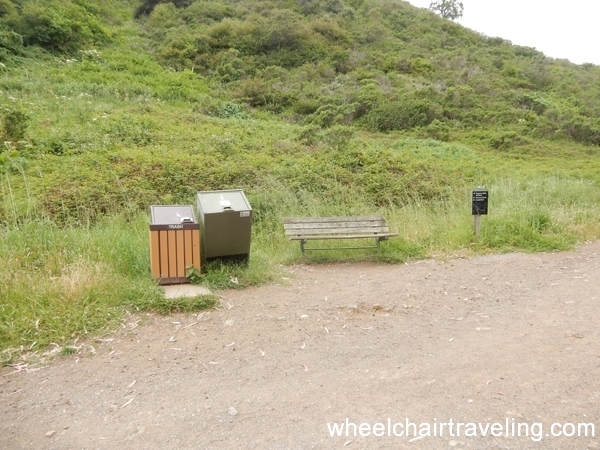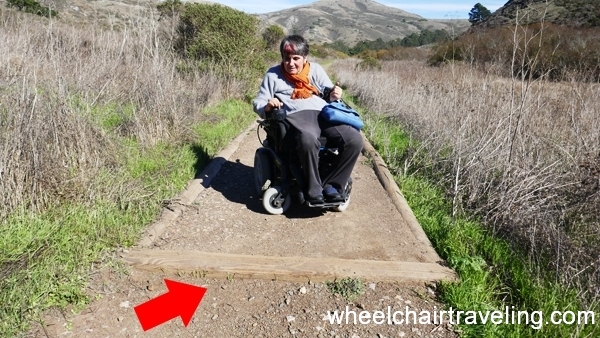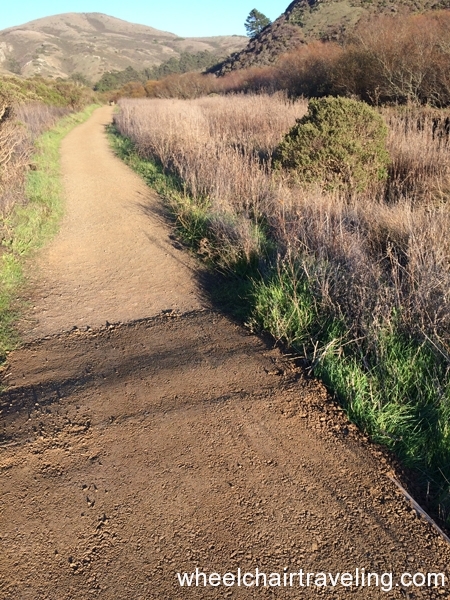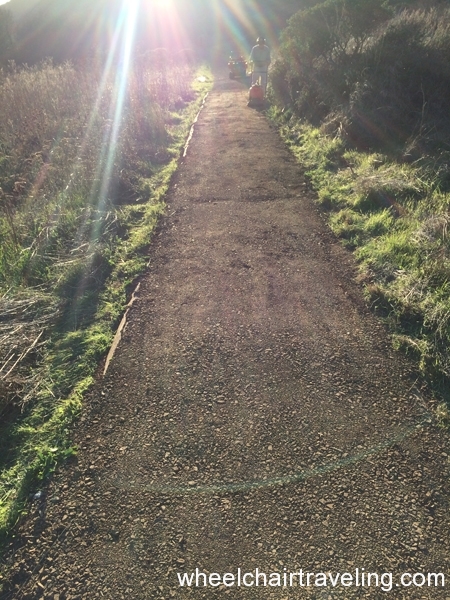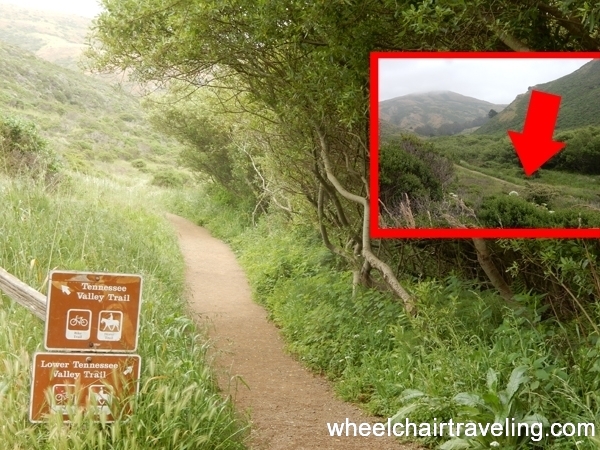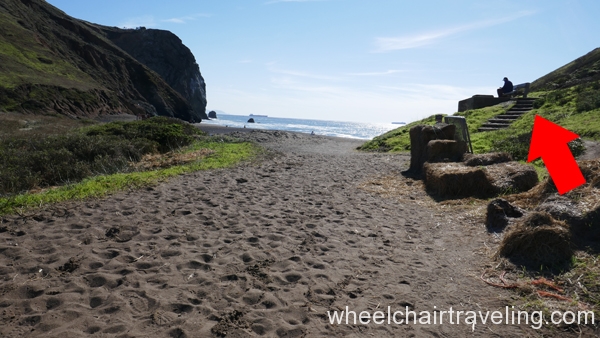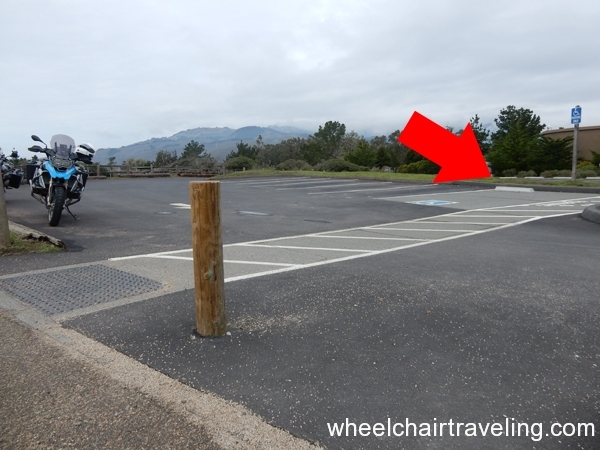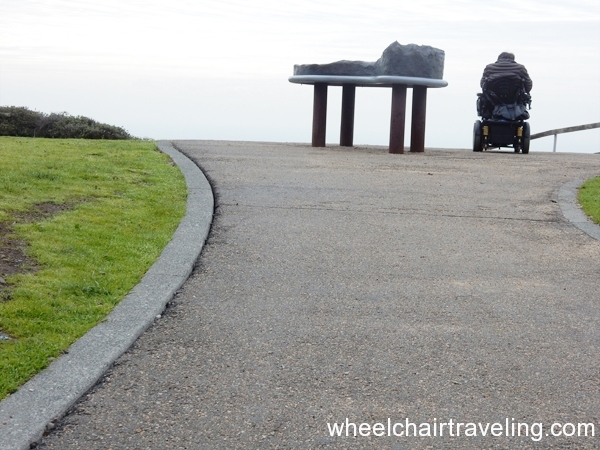The Marin Headlands National Park, managed by the Golden Gate National Recreation Area (GGNRA), is located right off the Golden Gate Bridge on the way to Sausalito from San Francisco in Marin County. The most popular area is Fort Cronkhite with Fort Baker on the bay side, Fort Barry in between, and Tennessee Valley in the northern highlands. The Marin Headlands National Park is large, too large to see and do everything in one day, even if looking for only barrier-free access. Also in the park are some of the GGNRA’s park partners that manage several other private properties found within the park, such as the Marine Mammal Center and Headlands Center for the Arts.
Highlights: All over the park are abandoned batteries to explore, built during the Cold War, with trails leading to or nearby them. A favorite trail that most will be able to do completely or partially is the Batteries Loop Trail in Fort Conkhite, where there is an ocean view even from the parking lot. The Rodeo Valley Trail and adjoining trails are alive with wildlife and are particularly lovely during the spring and fall. The trail and overlook at Battery Spencer in Fort Barry gets you close to the bridge and is one of the most popular stops. The nearby Battery 129 at Hawk Hill is also a favorite overlook spot. At the Visitor Center, pick up the password code to access a beach wheelchair at Rodeo Beach in Fort Cronkhite and plan for a tour of the Nike Missile Site. Picnicking at Rodeo Beach and Battery Wallace includes great views, barbecue grills, and modified access. In the Tennessee Valley, the Oakwood Valley Trail and the Tennessee Valley Trail may be worth exploring.
Basic Visitor Tips
- Visiting Seasons: Open year-round. Summers are normally dry. In the winter, trails are often saturated and trees can be down, plus other debris may create challenges or barriers.
- Park Phone Numbers: 415-331-1540; In case of emergency phone: 415-561-5656 or 911. Please note that emergency call boxes need service.
- Cell Phone Service: It depends on the provider. Little or no cell phone reception in most areas; Fort Baker has some service. The area near the bathrooms at Rodeo Beach in Fort Cronkhite by the bathrooms has been reported to also be a spot with a signal.
- Food & Water: Plan to bring your own. Water and a couple of other beverages along with energy bars, candy, and a few other light snacks are available at the Visitor Center. Drinking fountains are located at the Rodeo Beach Picnic Area. A restaurant and bar, Murry Circle, is located at the lodge at Cavallo Point in Fort Baker; the Travis Marina Bar and Presidio Yacht Club are at the marina in Fort Baker.
- Bathrooms: Most are vaulted toilets, aside from the ones at the Visitor Center, Rodeo Beach, and Muir Beach, and not all have running water (none have soap), so bring hand sanitizer.
- Driving: The nearest gas station is in Sausalito and Mill Valley. Many hills, turns and narrow roads in the park require diligent, focused attention while driving; make plans accordingly. One way to navigate between the two main fort sections is through a one-way tunnel with a 5-minute wait period. Another way is taking the windy Conzelman Road that hugs the cliffs, and at one point becomes one-way for about 3 miles. Many military batteries can be seen and explored along this road. The Tennessee Valley Area can only be reached by vehicle or hiking.
- Public Transportation: MUNI 76X Bus (Marin Headlands Express) provides accessible service on weekends and holidays from San Francisco to the Fort Cronkhite parking lot. The Marin Headlands Shuttle offers free transportation service each weekend from June/July through September (the actual starting date varies per season). The shuttle runs every thirty minutes from 9:00am to 6:00pm along Bunker Road, Field Road, and Fort Baker. Stops include Rodeo Beach, Visitor Center, Nike Missile Site, Battery Alexander, and Point Bonita Lighthouse. West Marin Stagecoach provides accessible public bus service to Fort Baker, every weekend from Memorial Day to Labor Day (including holidays). The service runs every 1–1.5 hours between 10am-9:30pm and travels to Sausalito, Marin City, Mill Valley, Stinson Beach, and Bolinas.
Fort Baker
Fort Baker is on the bay side of the Golden Gate Bridge and may seem larger than it is because of the tight concentration of buildings previously owned by the military. They are now overseen by the park service but managed by park concession partners, like the Bay Area Discovery Museum and the Cavallo Point—the Lodge at Golden Gate. Two fishing piers and a few trails around Fort Baker give views of the Golden Gate Bridge, San Francisco, and the surrounding area. Fort Baker has a lot of history around the property, and often at these points of interest, there is a sign with a phone number displayed to call in for more information. These signs are a part of the park’s cell phone audio tour.
Picnicking
The GGNRA manages the picnic spot at the Yellow Bluff overlook and the very next picnic spot less than a mile up East Road or the Bay Trail. They both have one large, designated parking spot with an accessible path to the picnic area and benches; no bathrooms. At Yellow Bluff, there are two picnic tables with extended ends for more access and the other spot has one such table.
There is one picnic table along the Horseshoe Cove overlooking the Golden Gate Bridge, located off the Bay Trail at a large parking lot on Sommerville Road, right by the U.S. Coast Guard office. An opening has been made for barrier-free access. A trashcan and a few backless benches are nearby. One designated parking spot is large enough for van access; no paved pad. This picnic area also has the San Francisco Bay Trail running on the perimeter
Fishing Piers
Within Fort Baker, visitors have access to two paved fishing piers with views of the Golden Gate Bridge. The first paved pier is at the tip of the Point Cavallo peninsula next to a few handicapped parking spots. This pier is about 6 feet wide. The other is off Moore Road with one van-accessible spot. Here, head to the right side where the entrance is widest; the pier itself is about 20 feet wide. On the other side of the Golden Gate Bridge on the Bay Trail is where Conzelman Road begins.
Hiking Trails
- Battery Yates (0.2 miles) and the Fort Baker Bay Trail (0.4 miles)
On the Fort Baker Marina peninsula, the Battery Yates Trail and the Fort Baker Bay Trail (FBBT) weave around Battery Yates on a small hill looking at San Francisco and the Golden Gate Bridge. A few large boulders jaggedly line the cove like arrowheads, creating picturesque silhouettes. The Battery Yates can be viewed from the road or trail. For a full loop go left when the trail ends to connect with the Fort Baker Bay Trail back to the parking lot.
Trailheads: The most accessible trailhead is from the east end of the Bay Area Discovery Museum parking lot; follow the trail up the hill and to the left. From the last parking lot, it is only possible to access the Fort Baker Bay Trail; at this point, the trailhead to the Battery Yates Trail is up a flight of stairs.
Trail Details: The accessible trailhead entrance to Battery Yates begins with an incline of about 7 degrees for roughly 100 yards. It is about 5-10 feet wide, with some areas a little more or less. The trail is made up of chert, a crushed dirt and rock mixture. Many portions of this trail were very rocky and thick. Due to the inclines and the thickness and size of the rocks on the trail, off-road wheelchairs or wheelchairs with power assistance is recommended.
Parking: The best access point to the Battery Yates Trail trailhead is parking at the Bay Area Discovery Museum parking lot off Sommerville Road; a road sign indicates access with the universal symbol. Two accessible paved parking spots are at the end of the marina at Point Cavallo; One of these is van accessible. One van-accessible parking spot is right before the yacht club.
Public Transportation: At the west end of the Bay Area Discovery Museum parking lot is a station stop for the Marin Headlands Shuttle.
- Battery Duncan (1.5 miles, one-way)
Drown Road is a small service road connecting Alexander Avenue and East Road. Along it is Battery Duncan; road signage is limited. The East Road trailhead has a dirt parking lot and from there is a small hill up to the trailhead. The opening to the left of the gate was enough for most wheelchairs. The service road continues under a grove of Eucalyptus trees and continues around a grass hill.
Pathway: The dirt service road is packed, but there are rocks a few inches in diameter and other natural debris and erosion. Power wheelchairs could more easily explore this trail, in good time, than manual chairs. The trail was wide enough for most wheelchairs to the battery. The gate at the trailhead was a little tight but doable; approximately 4 feet.
Parking and Bathrooms: No bathrooms. The parking lot and trail are dirt with no access modifications or designated spots of any kind.
Fort Barry & Kirby Cove
Tucked within the area between Fort Baker and Fort Cronkhite is Fort Barry, with less visible manmade infrastructure and more rolling hills and batteries. In addition to seasonal camping at Kirby Cove, this section of the park has breathtaking views of the Golden Gate Bridge and the San Francisco city skyline.
Battery Overlooks
- Battery Spencer (0.2 miles, one-way) is located along McCollough Road, just west of the Golden Gate Bridge on the peak of a hill. The trailhead requires fitting through a gate while moving through an uneven threshold. The trail is about 10 feet wide and gradually gets rockier the further you go. The trail splits into two hills not far from the parking lot. The hill to the left takes visitors to a relatively level platform that extends up another hill, and the other navigates through military buildings.
Parking and Bathrooms: There are 2 van accessible parking spots sharing the same crosshatch, with one vehicle backing up into the spot. The bathrooms with vaulted toilets are to the right before the gradual climb up a few hills. - Battery 129 at Hawk Hill is a popular point for visitors. Get a view of the Golden Gate Bridge from here, or you can go through the battery and up a short ramp (approximately 5 degrees in grade) to a relatively level viewing platform to see the Pacific Ocean, and if you are lucky, hawks flying. A short trail to the right goes a few yards before ending at the stairs. The upper section of Hawk Hill is incredibly steep and windy, mixed with turns and a cross-slope.
Parking and Bathrooms: Two accessible spots with van access; one requires backing up into the spot. There are three portable toilets of different sizes here, all with grab-bars. This is also where the road turns into a steep one-way for 3 miles, so plan your route accordingly; you can turn around at a parking lot at either the Upper Fisherman’s Trailhead, Black Sands Beach (nude beach) or the Battery Rathbone/Mclndoe. - Black Sands Beach: Has one van accessible parking spot plus a vaulted toilet. Access to the beach is via stairs only.
- Upper Fisherman’s Trailhead: Two paved handicapped parking spots are at this small overlook, but there is nowhere to go otherwise.
Kirby Cove (Day-Use and Overnight Camping)
Kirby Cove is a gated area surrounded by cypress and eucalyptus trees with intimate views of the water, San Francisco, and the Golden Gate Bridge. Kirby Cove has Battery Kirby and Battery Wagner, along with a day-use picnic spot and campgrounds. There is no running water at Kirby Cove.
- Reservations and Access: The one-way, one-mile, steep, and windy road to Kirby Cove is open from April 1 to November 30, and by reservation only. Hikers share this road, so be mindful. Upon reservation, campers will get the code to unlock gates at two different locations; one is at the beginning of the road (top of the hill), and another is right before the main area. If no accessible site is showing as available, please call the visitor center. For a reservation, please call, (415) 331-1540 or reserve online. Be sure to make accessibility needs clear. Opening and closing the gates is a challenge for some parties, especially at the first one where the incline is very steep and there is just enough room for a vehicle but certainly not a ramp.
- Batteries: Battery Kirby is located between the day-use picnic area and the campgrounds, right along the road, so there is no need to get out of the car if you don’t want to. Battery Wagner is also located in this gated area but is not accessible for most wheelchair users because the trail is very rocky for about 100 yards with about 8 degrees in grade.
- Day-Use Picnic Area: Before reaching the campground, you will see the Day-Use Picnic Area with two picnic tables, two adapted cooking grills, one adapted fire-pit, and one anti-raccoon food storage cabinet that’s within access. The pathway from the parking spot to the tables is at a slight incline of about 3 feet wide and made of firmly crushed red rock (no underlying foundation). A flat 5×5 overlook pad is just past the picnic tables and has a great view of the Golden Gate Bridge. One accessible parking spot is available; for the best van access, back into the spot because the accessible path of travel is on the left.
- Campground: Kirby Cove is the only campground out of four that has been modified per ABA standards. Reservations go very quickly. The two ABA-modified campsites are #2 and #5, with firmly crushed red rock pathways, like the day-use area. One site is slightly bigger with additional tent pads tucked in the grasses, but both have one raised and ground tent pad, one anti-raccoon food storage cabinet that’s within access, and one double-ringed fire pit with a cooking grill to prevent accidental burns. The ends of picnic tables can be accessed by one wheelchair but extended tables are planned for the future. Pathways connect the sites and lead to two accessible parking spots and then up a small incline to the bathroom (vaulted toilet).
Fort Cronkhite
Fort Cronkhite is very scenic and is the most populated area of the Marin Headlands, with more ocean views, trails, and batteries. The Visitor Center and Nike Missile Site are located here, along with the picturesque Rodeo Beach and Point Bonita Lighthouse. The Batteries Loop Trail above Rodeo Beach is a favorite hiking trail and scenic overlook, and other trails worth exploring are the wetlands and meadows off Bunker Road.
Visitor Center
The Marin Headlands Visitor Center is located just off Bunker Road on Field Road. The pathway to the entrance circles around and down to the door; one tiny section is pretty steep (8-10% grade). The door of the Visitor Center has been widened but does not open automatically. The ramp to the door veers off to a picnic area with a few tables; a few spots on the end are open but no extended tabletops for multiple wheelchairs.
The Visitor Center was once a chapel, which is obvious from the construction. The information desk is directly inside, sitting under an impressive replicated tree; a lowered desk is available for those in wheelchairs. The Marin Visitor Center has a nice display of the Native Americans and frontiersmen and women that worked this land, including partial home replications. Visual and tactile exhibits let visitors explore the environment at Marin Headlands. The back of the Visitor Center (old chapel altar) is a kid and sitting area, made accessible by a ramp.
- Food, Drinks, and Gifts: A drinking fountain is located at the back of the Visitor Center; otherwise, there is tea for sale along with other small snacks and a couple of drinks.
- Parking: One van accessible spot is located closest to the Visitor Center Entrance and another is on the opposite side of the parking lot near the bathrooms.
- Bathrooms: Two different types but both with flush toilets, roll-up sinks (no soap), and lowered hand dryers. One is a family unisex toilet located in the middle, and on either side is a bathroom for both men and women with stalls. One stall is more elongated and the other is more square-shaped. The accessible stalls have modified door handles, but only on one side.
The Nike Missile Site
The Nike Missle Site is open to the public on the first Saturday of every month; otherwise, the site has a locked gate. Just show up to begin the tour, and visitors needing accessible parking will be instructed where to do so. Parking is on a flat, paved surface. The whole tour usually takes about 60 minutes.
Visitors are led around the missile site and into a few buildings for closer displays of warfare; a short movie is also played. Warfare displays include viewing the Hercules up close and even watching a missile rise from the ground and into the sky. The area toured is paved and flat, and entrance into all but one of the buildings is barrier-free. Narrow manual wheelchairs may be able to access the operating room, which requires going up one large step, but this room can be seen from the outside. The first room of the tour features various displays as well as an informational video.
Rodeo Beach and Lagoon
Rodeo Beach is what draws many visitors to the Marin Headlands, with picturesque cliffs on either side that have been dramatically transformed by the waves. Here is where two beach wheelchairs are locked up and stored. A bridge takes people onto the beach. From Labor Day to Memorial Day, 200 feet of rubber beach mats are added to extend from the end of the bridge to the crest of the beach so visitors can view the ocean. During the wet months, mats are removed from the bridge because of flooding.
- Beach Wheelchairs: To get one of two beach wheelchairs that go over sand, head to the Visitor Center to get the password code for the lock; open from 9:30am to 4:30pm. One chair can accommodate up to 300lbs and the other 500lbs. The lockers are located right next to the bridge.
- Picnic Tables: At the farthest end of the parking lot is a picnic area where there are four tables with modified cooking grills. Space is open on either side of each table; plans are set for 2 of these tables to be extended for wheelchair access. You can also find a drinking fountain here and places to discharge trash and recyclable items.
- Lagoon Trail Loop (1.5 miles): The portion of this trail that parallels Mitchell Road to Rodeo Beach is barrier-free. On the eastern border of the lagoon, parking blocks restrict barrier-free entrance at most points. The trail has one hill (8-10 degrees in grade) with relatively flat ground in between and no cross-slope. When heading up the hill at the northeast point of the lagoon, there is a barricade on the roadside of the trail, but the trail is open on the waterside. One of the accessible trailheads is at an unmarked, dirt parking lot, across from the lagoon on the north-east tip. No designated parking, but visitors can cross the road using the pedestrian crosswalk to reach the trail. Otherwise, park at a designated accessible parking spot at the bridge to the beach, where the beach wheelchairs are located. Barrier-free access ends at the top of the lagoon, where the trail continues downstairs or left into a dirt parking lot. The Lagoon Trail does connect at the Visitor Center, but this trailhead is not accessible. Along Mitchell Road, parking blocks restrict access to this trail.
- Battery Townsley Trail (1.5 miles, semi-loop): This steep, paved trail is a service road, Old Bunker Road, which takes visitors from Rodeo Beach to Battery Townsley and ends at the Marine Mammal Center. Paved parking lots are on either side of the semi-loop with designated accessible spots.
- Parking and Bathrooms: Right by the bridge, there are several designated accessible parking spaces, and at the end of the parking lot by the picnic tables and bathrooms, there are four more. This bathroom, with flush toilets, has two family-unisex units, plus both a men’s and women’s bathroom, each with an accessible stall. Bathrooms have grab-bars, roll-up sinks, and lowered hand dryers. This bathroom area is unique because it also has a shower with a bench, but the bench is far away and does not reach the water, so unless you have your own, the shower is not accessible.
Batteries, Hiking Trails, Overlooks, and a Lighthouse
- Battery Wallace and Picnic Area (0.1 miles): Located right above the Nike Missile Site, off Conzelman Road, and after Battery Rathbone/Mclndoe. The picnic area has access to 3 tables that each have barbecue grills. None of the tables have extended tops. There is one van-accessible parking spot and a vaulted toilet. From the parking spot, head across the road and to the left for about a dozen yards. The road is paved and there is a designated accessible pathway once you get closer to the battery. Access inside the battery is possible, but a curb, followed by grass prevents further exploration.
- Batteries Loop Trail (0.3-0.4 miles): This trail is the barrier-free route to Battery Alexander, Battery Smith-Gutherie, and Battery O’Rorke. The trail loops around the Pacific Ocean to Battery Smith-Guthrie; in either direction, you will have to navigate up and down a few hills. From this loop trail, you can access Battery O’Rorke down a short incline side trail on the northwest. side Another side trail to Battery Alexander from the loop on the southeast side has a long, hill-ridden route that ends at stairs. The parking lot also shares the trailhead for the South Rodeo Beach Trail. Next to the vaulted toilets, is one van-accessible parking spot on top of a level, asphalt pad. A pathway wraps around the parking lot to the trailhead, but the parking lot was a smoother route for a manual wheelchair.
- South Rodeo Beach Trail (0.2 miles, one-way): Not accessible; located right by the Batteries Loop trail in the same parking lot. The trail is a steep incline down to the ocean with a set of stairs at the end.
- Rodeo Valley Trail (0.9-1.5 miles, one-way): The main trailhead is located off a paved parking lot with 5 designated handicapped spots on Bunker Road, with a modified, vaulted unisex toilet that was installed in 2016. The other trailhead is at an unmarked, dirt parking lot with one small building, located on the other side of the road from horse stables. The trail passes through a heavily vegetated part of the wetlands meadows, under some tree shade, across two bridges, and into grassland wildlife. This area is where birds, butterflies, and dragonflies flutter and feed. The Rodeo Valley Trail connects with both the Milwok and Bobcat Trails.
- Milwork Trail (0.5 miles, one-way): The trailhead begins at a seemingly unmarked dirt parking lot with one building; an accessible portable toilet is around the corner. Trailhead signs may be difficult to spot from the road. This trail connects with the Rodeo Valley and Bobcat Trails before turning into other trails, and re-appears in the northwest section of Tennessee Valley. About a half-mile into the trail is a grove of eucalyptus trees. Due to the battery life of a power wheelchair, the entire trail has not been completed.
- Bobcat Trail (one way): A section of it heads uphill to the top point while the lower portion travels through wetlands and meadows, alive with wildlife. After the intersection of the Bobcat and Rodeo Valley trailheads, the trail becomes bumpier due to larger rocks; the grass is also growing in lined sections. Also at this point, the trail begins to significantly climb in grade/slope. The trail meanders up the rocky hill overlooking the valley below with views of the ocean and continues inward east towards Tennessee Valley, connecting with other trails along the way. Due to the battery life of a power wheelchair, the entire trail has not been completed.
- Battery Mendell Trail (0.2 miles, one-way): The Battery Mendell Trail takes you right past Battery Mendell to an overlook for Bird Island along the Pacific Ocean. Two accessible parking spots with van access are located at the trailhead right in front of a modified vaulted toilet. The first few yards have about a 4-5 degree incline and then the 10-foot-wide trail gradually meanders upwards. From the parking lot, the Mendell trail also travels northeast towards the Nike Missile Site. It runs along the road and cliff-side (no railing) with dips and some eroded sections. For safety reasons, this section of the trail is not recommended.
- Point Bonita Lighthouse (0.5 Miles, one-way): The lighthouse is a main attraction of the park, but accessing it has its challenges and cautions. Wheelchair access inside the lighthouse is not possible. The trail is mostly paved and is a long incline down to the lighthouse; power assistance is recommended for the hike back to the trailhead. About a third of the way on the trail is an area that rangers estimate to be 18-22 degrees in grade, right along the cliffs. This section is heavily sprinkled with falling rocks, so traction becomes limited or non-existent. Once past this point, there are no more hills. Just past the trailhead is a sign for the cell phone audio tour. There is one van-accessible parking space at the loop and one also where Battery Mandell is located (additional spot at this trailhead along with vaulted toilets).
- Battery Rathbone/Mclndoe: Located on the one-way portion of Conzelman Road right off the side of the road, so you don’t have to get out. No designated parking of any kind.
Tennessee Valley
To reach Tennessee Valley by vehicle, visitors must travel outside the park temporarily to 101 North toward Marin City and then exit on Tennessee Valley Road in Mill Valley. This area of the Marin Headlands National Park consists of woodsy and grassland habitats. Some visitors may be able to hike all of the lower Tennessee Valley Trail that passes a lagoon before reaching the Pacific Ocean.
Trails
- Tennessee Valley Trail (1.8 miles, one-way): This trail is also known as the Valley Trail and stretches out to Tennessee Beach. At the trailhead is a small picnic area and vaulted toilets; tabletops are not extended. Four accessible parking spots are available. The first quarter of a mile on the Tennessee Valley Trail is paved and then becomes naturally packed dirt. The Haypress Camp Trail veers off to the right from this trail, which leads to a campsite. There is also one bench less than a quarter-mile into the trail. Another bench near the lagoon and ocean, but it is located up about twelve steps. A couple of hills are along this trail, which is also rocky, so power assistance is beneficial. At one point, the trail splits into the upper and lower Tennessee Valley Trails; the lower one is the easier route. When going through the meadow, a section before and after the bridge has trail boarders, but also horizontal boards every few yards, which can prevent some power wheelchairs from crossing. Trail improvements cover these sections to remove any barriers, but may get eroded. Close to the beach is a unisex vaulted toilet along with a couple of picnic tables in the grass and a call-box. At one point, the trail splits into the upper and lower Tennessee Valley Trails; the lower one is the easier route. Close to the beach is a unisex vaulted toilet along with a couple of picnic tables in the grass and a call-box. During the wet season, large puddles can form on sections of the trail, especially close to the beach.
- Oakwood Valley Trail (0.7 miles, one-way): The trailhead is located near the Tennessee Valley sign and Oakwood Meadow Trail trailhead in a dirt parking lot. There is also parking along the street wherever you can find it. This trail is very popular for dogs. It meanders through trees and partly along a creek with rows of ferns. This trail connects to both the Alta Trail and the Oakwood Meadow Trail. This trail varies in rockiness, which can be too bumpy for some, so paying attention to and modifying routes is required. Furthermore, although this remains at least 4 feet wide (sometimes much wider), the cross-slope may hinder balance in some spots.
- Oakwood Meadow Trail (0.1 miles, one-way): This trailhead is located directly next to the Tennessee Valley sign. Barrier-free access ends about 100 feet into the trail. Some manual wheelchairs may be able to overcome these barriers with assistance, but it may not be worth the effort. This trail is a little over 3 feet wide and made up of a firmly packed surface. The end of this trail connects with the Oakwood Valley Trail. From this point, barrier-free access goes for about 100 feet before there is a step.
- Alta Trail: This trail is at the end of the Oakwood Valley Trail. It travels up an incline to the city of Marin. Due to severely uneven cross-slope and muddy conditions, only 0.2 miles have been explored. This trail is still under access review.
- Fox Trail (0.7 miles, one-way): This trail takes off from the Tennessee Valley Trail and connects to the Coyote Ridge Trail. This trail is still under access review.
- Coyote Ridge Trail (0.7 miles, one-way): Starts from the Fox Trail. A little under halfway along this trail, the Green Gulch Trail interconnects. This trail is still under access review.
- Green Gulch Trail (3.3 miles, loop): Located near the coast of the Pacific Ocean on the northwest side of the park near Muir Beach and Overlook. The trail itself connects with the trail at Muir Beach. This trail is still under access review.
Haypress Trail and Campgrounds (0.6 miles, one-way)
People have to walk to this campsite from the parking lot, but if unable to do so, please contact the park to arrange for a ranger to open the gate. Due to the remoteness of this area, coupled with the thick grasslands and trees, this campsite restricts campfires. Only a handful of sites are available, and there are plans to make one of the campsites accessible with an adapted picnic table and barrier-free pathways. There is a modified, vaulted unisex toilet on-site.
Muir Beach
Muir Beach is located on Highway 1 off the way to the Muir Beach Overlook and Muir Woods.
- Picnic Tables: Off the parking lot with views of Muir Beach are a few picnic tables. A short, bordered ramp leads down to the tables. One of the picnic tables has a slightly extended end to accommodate multiple wheelchairs.
- Trail (0.2-0.5 miles, one-way): At the trailhead, near the bathrooms and parking, is a 3-dimensional tactile model of the Muir Beach area. This model was designed so that most wheelchairs would be able to roll-up under it, for viewing. The trailhead then crosses over a bridge for a view of the wetland meadow. On the bridge are a couple of informational display boards about the natural wildlife in the area, one of which is a tactile display. At the end of the bridge the trail splits. To the right, the trail quickly ended at the beach, and to the left, the trail continues deeper into the wetlands meadow. This section of the trail is about 6 feet wide. Not long after the split, the trail intersects with a water bar that’s a few feet wide made up of stone. The uneve6363n, slick surface is impassable for most wheelchairs. This trail then connects to the Green Gulch Trail.
- Beach Wheelchair and Beach Access: One beach wheelchair is locked up and stored at Muir Beach near the restrooms. To obtain this chair, calling 415-561-4700 in advance is recommended because cell phone reception is either not reliable or nonexistent. You can also go to the Visitor Center in Fort Cronkhite. This beach wheelchair is the same design type as the ones at Rodeo Beach. At the beach, visitors will find a firm, 4-foot-wide beach mat to get across the sand for about 20-50 feet; the initial trailhead to the beach mat is about 5 degrees in grade.
- Parking and Bathrooms: A few designated, accessible parking spaces, on a paved lot, are placed closest to the bathrooms and the trail to the beach. Bathrooms for both men and women have flush toilets and have been modified for access, equipped with grab-bars and a roll-up sink.
Muir Beach Overlook
The Muir Beach Overlook is located just up the way from Muir Beach on the way to Muir Woods. Its location sits above Muir Beach for a scenic view of the coast. Getting around is possible on paved pathways.
- Picnic Tables: There are four picnic tables located by the accessible section of the overlook, and another is southeast of these and connected by a paved, level walkway. No picnic table has a modified extended end to accommodate multiple wheelchairs.
- Overlook: At the point of the Muir Beach Overlook is a 3-dimensional, tactile model of the surrounding area, similar to the one found below at Muir Beach, including the wheelchair space. The incline up to this model is about 7 degrees in grade for about 50 feet. In addition to the model, three informational display panel boards are closest to the water; blocking the edge of the cliff is a two-tiered handrail. This overlook also encompasses a small opening to a battery that can easily be seen from this overlook point. Hundreds of stairs hike down to the main overlook point, jetting out into the Pacific.
- Trail: The Owl Trail has a trailhead at the Muir Beach Overlook but is not barrier-free. The trail is narrow along the shoreline with no railing.
- Parking and Bathrooms: One designated, van-accessible parking spot is located closest to the first overlook area. The other designated spot is next to the bathroom; a trail travels about 100 feet up a gradual incline from the other designated accessible parking space to the overlook.
Last updated on July 5, 2023






















